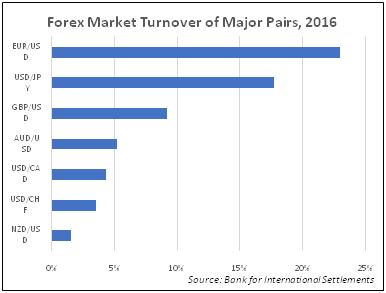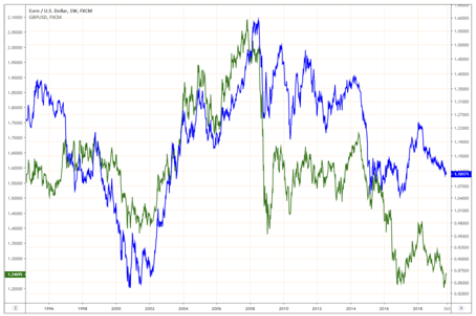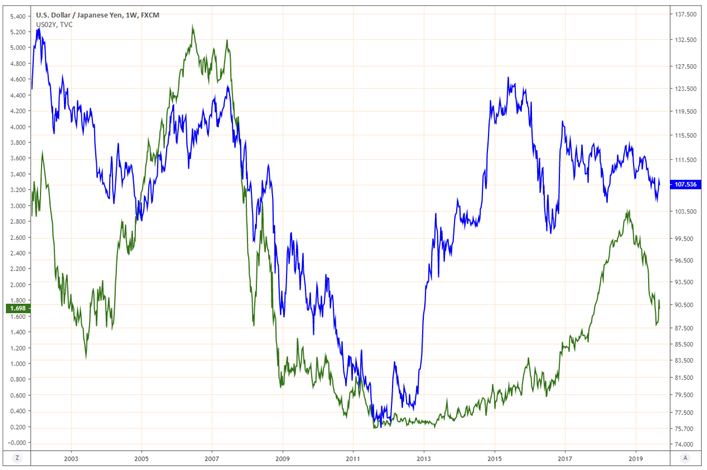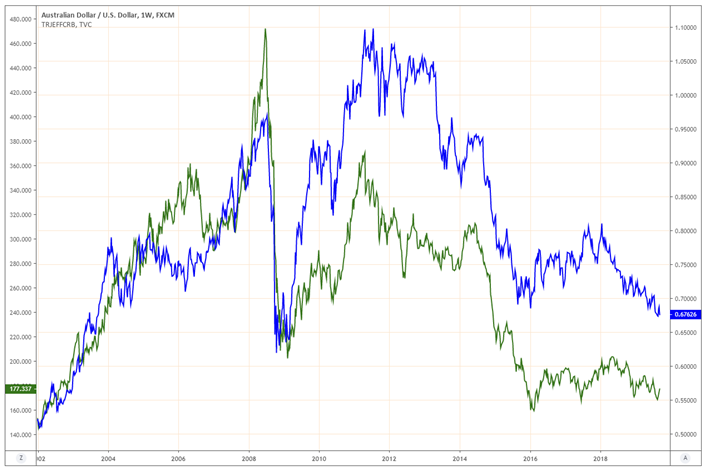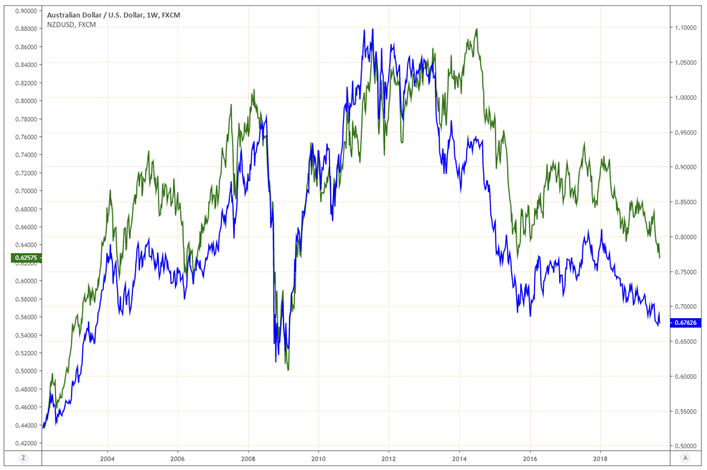
The objective of this chapter is to talk about the major currencies (aka the Majors).The Majors are the most popular, liquid, and important currencies that are traded against the Dollar. Remember, when we say the Dollar, we are by default referring to the US Dollar.
The Majors
While there is no strict definition for the Majors, generally, the Majors aresevenof the most popularly tradedcurrencies against the Dollar. These include the Euro, the Japanese Yen, the Pound Sterling, the Swiss Franc, the Australian Dollar, the Canadian Dollar, and the New Zealand Dollar. The chart to the right shows the daily turnover (in%) of each of these currency pairs in 2016. As can be seen, nearly half of the transactions take place in just three currency pairs - EUR/USD, GBP/USD, and USD/JPY. In fact, over two-fifth of the transactions take place in just two currency pairs - EUR/USD and USD/JPY. We will now discuss each of these currency pairs in greater detail.
EUR/USD
This is the most traded currency pair in the world, contributing to nearly a fourth of the daily Forex turnover. When someone says the Dollar has strengthened (or weakened), he or she is usually referring to the Dollar strengthening (or weakening) against the Euro. Such is the popularity of the common European currency around the world. The pair is heavily impacted by economic data and news flows from the US and the Euro area. Strong economic data from the Euro area tends to lift the pair higher and vice versa, while strong economic data from the US tends to drag the pair lower and vice versa.
Each currency in the pair is managed by two of the most powerful central banks in the world - the Federal Reserve, which manages the Dollar, and the European Central Bank (ECB), which manages the Euro. In order to trade the pair, one must closely monitor what kind of monetary policy is in play in each of these regions. Generally, if the ECB is more hawkish than the Fed, the pair is likely to strengthen; while if the Fed is more hawkish than the ECB, the pair is likely to weaken. The current trajectory of interest rates and, more importantly, the future trajectory of interest rates in these two regions have a strong influence on determining the trajectory of the currency pair.
Some of the key factors to keep a track of when monitoring the pair include:
-
The ECB and the Fed monetary policy meeting.
-
The policy guidance of each of the two central banks.
-
The trajectory of the interest rate differential between the two regions.
-
Periodic comments from ECB and Fed officials.
-
Key US and Euro zone economic data.
-
Short-term and long-term bond yields across the Euro area and the US, to understand the market’s perception of interest rates.
-
Prevailing risk sentiment in the market. The pair tends to rally when risk appetite is strong, and vice versa.
USD/JPY
This is the second most traded currency pair in the world, accounting for over a sixth of the daily Forex turnover. TheJapanese Yen is a proxy for the prevailing risk sentiment in the market, because it isconsidered one of the safest currencies in the world. It has been frequently observed that during times of global economic uncertainties, the pair tends to decline; while during times of global economic strength, the pair tends to rally. There are a few reasons why this happens, as stated below.
-
Japan exports more than it imports, because of which it has been consistently enjoying a trade surplusover the years. Strong trade position compared to other nations tends to benefit the Japanese currency during times of economic uncertainties.
-
Because of years of near-zero interest rates in Japan, Japanese investors have invested significant sums in other nations to earn higher yields.As a result, Japan has become the world’s largest creditor nation, meaning other countries owe more to Japan than Japan owes to them. As a result, during times of global uncertainties, capital tends to repatriate into Japan, strengthening the Yen, and vice versa.
-
Japan’s ultra-low interest rates have made the Yen a favourite funding currency in carrying out “carry trade” transactions. However, when global economic conditions deteriorate and risk aversion increases, these carry trade transactions unwind, causing repatriation back into Japanese Yen.
The pair is impacted more by US economic data than it is by the Japanese economic data. Stronger data from the US tends to lift the pair higher, while weaker data from the US tends to drag the pair lower. The Japanese Yen is managed by the Bank of Japan (BoJ), which is again one of the most powerful central banks in the world. The path of the monetary policy as well as the tone of the two central banks play a key role in driving movements in the pair.
Some of the key factors to keep a track of when monitoring the pair include:
-
The BoJ and the Fed monetary policy meeting.
-
The policy guidance of each of the two central banks.
-
The trajectory of the interest rate differential between the US and Japan.
-
Periodic comments from ECB and BoJ officials.
-
Key economic data, especially those from the US.
-
Short-term and long-term bond yields across Japan and the US, to understand the market’s perception of interest rates.
-
More importantly, keep a close watch on the 2-year bond yields of the US. The pair has a very strong positive correlation with the 2-year US yield.
-
Prevailing risk sentiment in the market. The pair tends to rally when risk appetite is strong, and vice versa.
GBP/USD
After EUR/USD and USD/JPY, the GBP/USD is the third most traded currency in the world, accounting for over9% of the daily Forex turnover. The pair is quite sensitive to economic developments that take place in Europe. This is not so surprising as more than two-third of Britain's trade is conducted within Europe, making the nation and subsequently its currency quite sensitive to prevailing economic conditions in Europe. As such, movements in the pair are also closely impacted by movements among the GBP crosses, especially the EUR/GBP cross.
Movements in the pair are heavily impacted by economic data from Britain and the US. Stronger data from Britain usually leads to an appreciation in the pair and vice versa, while stronger data from the US usually leads to a depreciation in the pair and vice versa. Compared to EUR/USD, USD/JPY, and USD/CHF, GBP/USD is quite sensitive to economic data from either regions. Hence, it makes sense to closely monitor economic reports from each of Britain and the US. Besides, as a majority of Britain's trade is done within Europe, the pair is also marginally impacted by economic data from Euro zone. Signs that the Euro area economy is strengthening tend to support the Pound, and vice versa. In the next chapter, we will talk about this in a greater detail.
The central banks that most influence the direction of the pair are the Federal Reserve and Bank of England (BoE). Over the last decade, the pair has been more sensitive to policy actions of the Federal Reserve than that of the BoE. The key reason for this is because the Bank of England has not changed its policy much over the last decade. In fact, since the 2008 Global Financial Crisis, the BoE has changed its policy rates just thrice, a cut in 2016 followed by two hikes in 2017 and 2018 respectively. On the other hand, the Federal Reserve has done a series of rate hikes and is now on a rate cut trajectory.
Some of the key factors to keep a track of when monitoring the pair include:
-
The BoE and the Fed monetary policy meeting.
-
The policy guidance of each of the two central banks.
-
The trajectory of the interest rate differential between the two regions.
-
Periodic comments from BoE and Fed officials.
-
Key US and UK economic data.
-
Key economic data from the Euro area, as it is the UK’s largest trading partner.
-
Prevailing risk sentiment in the market. The pair tends to rally when risk appetite is strong, and vice versa.
USD/CHF
The USD/CHF is not as much traded as EUR/USD, USD/JPY, or GBP/USD. As a matter of fact, it is not even traded as much as AUD/USD or USD/CAD. Nevertheless, despite this, USD/CHF is a major currency pair and is also a part of the G4 currency pairs (which includes each of the pairs mentioned above and USD/CHF. Just like the Japanese Yen, the Swiss Franc is also considered as a safe haven currency. In the aftermath of the Global Financial Crisis and the Euro zone Sovereign Crisis, the Swiss unit witnessed relentless inflows against most of its key counterparts, leading to a significant appreciation in the Franc and threating the nation's export sector.
One of the major factors that impacts the direction of the pair is economic developments in Europe. In fact, movement in the pair is not as much impacted by data releases from Switzerland or the US, as it is impacted by news flows from Europe. One of the key reasons for this behaviour is that more than four-fifths of Switzerland's international trade takes place with European countries. Also, as per the World Bank data, exports contribute to nearly two-thirds of Switzerland’s GDP. As a result of both these factors, economic health of Europe in general has a strong influence on determining the trajectory of USD/CHF (we will talk more about how the EUR impacts USD/CHF in the next chapter). The stronger the European economy, the stronger would be the demand for Swiss exports and subsequently the Swiss Franc.Having said that, in case of economic weakness in Europe or in other parts of the world, there is a tendency for the Swiss Franc to appreciate rather than depreciate. The reason why this happens is because of the Swiss unit’s safe haven status, as was mentioned earlier.
The central banks that most influence the direction of the USD/CHF pair are the Federal Reserve, the Swiss National Bank (SNB), and to some extent the ECB. Hence, one must closely monitor activities of these central banks. Besides, the pair is also influenced by economic data from Switzerland and the US. Stronger data from Switzerland tends to drag the pair lower and vice versa, while stronger data from the US tends to lift the pair and vice versa.
Some of the key factors to keep a track of when monitoring the pair include:
-
The SNB and the Fed monetary policy meeting.
-
The policy guidance of each of the two central banks.
-
The trajectory of the interest rate differential between the two regions.
-
Periodic comments from SNB and Fed officials.
-
Key US and Swiss economic data.
-
Key economic data from the Europe, as it is Switzerland’s largest trading partner.
-
Prevailing risk sentiment in the market. The pair tends to rally when risk appetite is strong, and vice versa.
AUD/USD
The AUD/USD is the fourth most traded currency pair in the world, accounting for just over 5% of the daily Forex turnover. Thereare several factors that impact the trend of AUD/USD. For one, the pair is influenced by economic data from the US and Australia. Strong data from Australia tends to lift the pair and vice versa, while strong data from the US tends to drag the pair lower and vice versa. Besides, the pair is also heavily impacted by the policy actions of the Federal Reserve and the Reserve Bank of Australia (RBA). In order to trade the pair, one must keep a close watch on the monetary policies of the US and Australia. Generally, if the RBA is more hawkish than the Fed, the pair is likely to strengthen; while if the Fed is more hawkish than the RBA, the pair is likely to weaken.
Among the developed world, Australia has one of the highest interest rates. Hence, the pair is heavily impacted by interest rate differential between the US and Australia. Higher the interest rate differential, the better is it for AUD/USD, and vice versa. Meanwhile, the Aussie (i.e. the Australian Dollar) is one of the favourite destinations for conducting carry trades because of the high interest rates in the nation. As the Japanese Yen is heavily used as funding currency to conduct carry trades, trends in the Aussie are also impacted by movements in the Japanese Yen. Hence, it also worth keeping an eye on the AUD/JPY cross. Besides these factors, there are a few other crucial factors that impact the pair as much as the above mentioned factors do. These are commodity prices, China, and global risk appetite. Let us now talk about each of these.
Commodity prices
The Australian Dollar is heavily impacted by the price trends of commodities. This is because Australia is a huge producer and exporter of several commodities, ranging from agricultural produce to metal and energy commodities. As such, price trends of commodities tend to have significant impact on the price trend of the Australian Dollar. The AUD/USD shares a strong positive correlation with commodities. Rising commodity prices is positive for the pair, and vice versa. One must keep a close watch on commodity index, such as the CRB Commodity index, in order to better analyze the trend of AUD/USD.
China
China has a significant impact on the Aussie. This is because China is Australia’s largest trading partner, both in terms of imports and exports. As per the data from Australia’s Foreign Trade board, China accounted for nearly a third of the Australian exports and nearly a fifth of the Australian imports. Hence, strength of the Chinese economy has a strong impact on the AUD/USD pair. Strengthening Chinese economy is positive for pair, and vice versa.
Global risk appetite
Because Australia has one of the highest interest rates in the world and is a commodity-driven economy, it is closely impacted by the prevailing risk sentiment in the market. Stronger risk appetite supports commodities and higher-yielding currencies, which in turn lifts the pair higher. On the other hand, risk aversion puts downward pressure on commodities and higher-yielding currencies, which in turn drags the pair lower.
Some of the key factors to keep a track of when monitoring the pair include:
-
The RBA and the Fed monetary policy meeting.
-
The policy guidance of each of the two central banks.
-
The trajectory of the interest rate differential between the two regions.
-
Periodic comments from RBA and Fed officials.
-
Key US and Australian economic data.
-
Economic health of China, as it is Australia’s largest trading partner.
-
The trend of commodity prices, as Australia is a major producer and exporter of several commodities.
-
Movements in the Japanese Yen, as the Aussie and the Yen are two of the most traded currencies for carry trade purposes.
-
Prevailing risk sentiment in the market. The pair tends to rally when risk appetite is strong, and vice versa.
USD/CAD
The USD/CAD is the fifth most traded currency pair in the world, accounting for just under 5% of the daily FX volumes. Just like in case of other currency pairs, movement in USD/CAD is impacted by the US and Canadian economic health. In fact, US economic data has more impact on the pair than does the Canadian economic data. The reason why this is the case is two-folds. One is that Canada is an export-driven economy. The second is that nearly three-fourth of Canadian exports go to the US. As a result of this, the health of the US economy has a strong impact on the health of the Canadian economy. The stronger the US economy, the stronger would be the Canadian economy, and vice versa. While in the medium to long-term, movement in the pair is heavily influenced by the health of the US economy, in the short-term, the pair is as sensitive to Canadian economic data as it is to the US data. Usually, stronger data from the US lifts the pair higher and vice versa, while stronger data from Canada drags the pair lower and vice versa.
The two central banks that most influence the direction of the pair are the Federal Reserve and the Bank of Canada (BoC). Generally, if the Fed is more hawkish than the BoC, the pair is likely to strengthen; while if the BoC is more hawkish than the Fed, the pair is likely to weaken. As already stated, Canada relies heavily on export of goods and services. And the largest component of its exports is crude oil (around a sixth of the nation’s total exports). In fact, the pair has an excellent negative correlation with the price of WTI crude oil. Rising crude oil prices tend to drag the pair lower, while falling crude oil prices tend to lift the pair. In other words, Canadian Dollar and crude oil price usually tend to move in the same direction. The reason for this correlation is that Canada is the fourth largest producer and exporter of crude oil, of which more than 90% goes to the US. The stronger the US economy, the stronger would be their oil imports from Canada, which in turn would mean greater inflows of US dollars into Canada.
Some of the key factors to keep a track of when monitoring the pair include:
-
The BoC and the Fed monetary policy meeting.
-
The policy guidance of each of the two central banks.
-
The trajectory of the interest rate differential between the two regions.
-
Periodic comments from BoC and Fed officials.
-
Key US and Canadian economic data.
-
Economic health of the US, as it is Canada’s largest trading partner.
-
The trend of crude oil prices, as Canada is the fourth largest producer and exporter of oil.
NZD/USD
The last of the Majors that we would be talking about is the NZD/USD currency pair. The pair is impacted by economic reports from the US and New Zealand. Usually, stronger data from the US drags the pair down and vice versa, while stronger data from New Zealand lifts the pair and vice versa. The central banks that most impact the pair are the Federal Reserve and the Reserve Bank of New Zealand (RBNZ). Generally, if the Fed is more hawkish than the RBNZ, the pair is likely to weaken; while if the RBNZ is more hawkish than the Fed, the pair is likely to strengthen. Just like the Australian Dollar, the New Zealand Dollar is also a commodity-driven currency, as New Zealand is renowned for the exports of several agricultural produce such as meat and dairy products. Hence, the pair is sensitive to fluctuations in commodity prices. Rising commodity prices tends to support the pair, and vice versa.
The health of the New Zealand economy is strongly influenced by the health of the Australian and the Chinese economy. This is because Australia and China are New Zealand’s largest trading partners, who combined account for nearly two-fifths and nearly a third of New Zealand’s exports and imports, respectively. Hence, the stronger the Chinese and the Australian economy, the stronger would the demand for New Zealand's exports, subsequently benefiting the pair. On the other hand, the weaker the Chinese and the Australian economy, the weaker would be the demand for New Zealand's exports, subsequently dragging the pair down. Also, being a pair that is sensitive to trends in commodities, NZD/USD is a risk-on currency pair, tending to rally when risk appetite is strong and global growth prospects are bright; and weaken when risk appetite is weak and global growth prospects are bleak.
Some of the key factors to keep a track of when monitoring the pair include:
-
The RBNZ and the Fed monetary policy meeting.
-
The policy guidance of each of the two central banks.
-
The trajectory of the interest rate differential between the two regions.
-
Periodic comments from RBNZ and Fed officials.
-
Key US and New Zealand economic data.
-
Economic health of the China and Australia, as they are New Zealand’s largest trading partner.
-
Movement in AUD/USD, as NZD/USD usually tends to move in sync with it.
-
Prevailing risk sentiment in the market. The pair tends to rally when risk appetite is strong, and vice versa.
Historical Charts
The above chart is the weekly chart of EUR/USD (blue line) and GBP/USD (green line). Notice that both the pairs tend to move in sync most of the times. Sometimes, EUR/USD turns direction first and GBP/USD follows in a few weeks, while on other times GBP/USD turns direction first and EUR/USD follows in a few weeks. There are also occasions when both the pairs change direction at roughly the same time. Hence, onemust keep a track of both the pairs to identify relative strength of each pair as well as to spot divergences between the pairs.
The above chart is the weekly chart of USD/JPY (blue line) and the US 2-year Treasury Bond yield (green line). Observe the positive correlation between the two. Rising yields in the US make US assets more attractive, thereby increasing inflows into the US and underpinning the Dollar. Notice that during the 2008 recession, the fall in US 2-year yield coincided with a steep decline in USD/JPY (i.e. the Japanese currency strengthened because of safe haven flows)
The above chart is the weekly chart of AUD/USD (blue line) and Thomson Reuters CRB Index (green line), an index that tracks the performance of several commodities. Observe how strongly the two are correlated. As Australia is a major producer and exporter of several commodities, strengthening commodity prices tend to underpin AUD/USD, and vice versa. Observe how a peak in commodities in 2012 led to a major peak in AUD/USD.
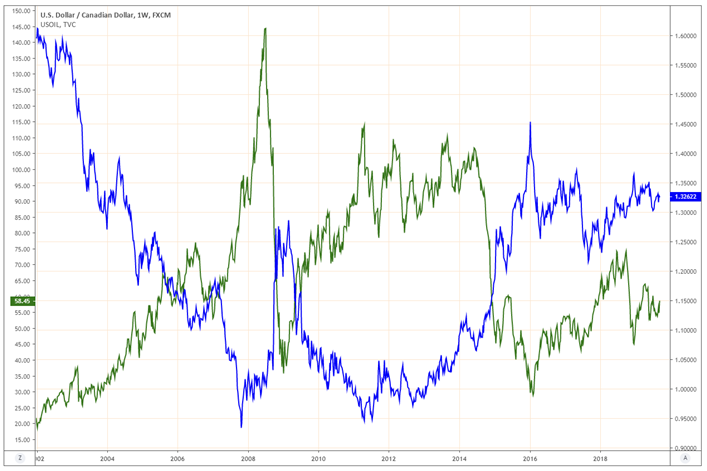
The above chart is the weekly chart of USD/CAD (blue line) and NYMEX WTI Crude oil (green line). Notice the strong negative correlation between the two. Observe how a peak in oil price usually coincides with a bottom in USD/CAD, and vice versa. The reason for this correlation is the fact that Canada is one of the world’s largest producer and exporter of crude oil. Rising oil prices tend to increase inflows of US Dollars into Canada, which in turn benefits the Canadian Dollar (as US Dollars are eventually converted into Canadian Dollar), and vice versa.
The above chart is the weekly chart of AUD/USD (blue line) and NZD/USD (green line). Notice the very strong correlation between the two. A rise in AUD/USD usually lifts NZD/USD too, and vice versa. This correlation exists because Australia is New Zealand’s major trading partner, in terms of both imports and exports. Also, just like in case of AUD/USD, NZD/USD is a major producer and exporter of commodities (especially agro-commodities), hence it is more sensitive to fluctuations in commodity prices.
Next Chapter
Comments & Discussions in
FYERS Community
